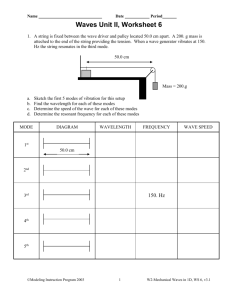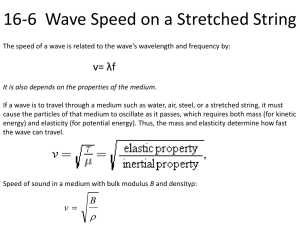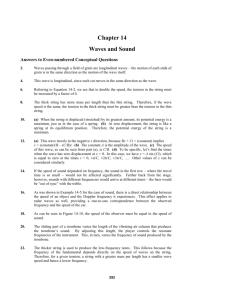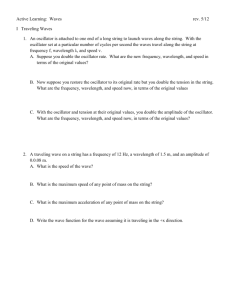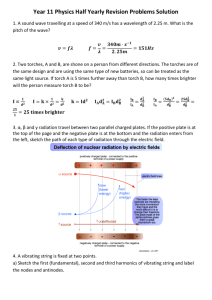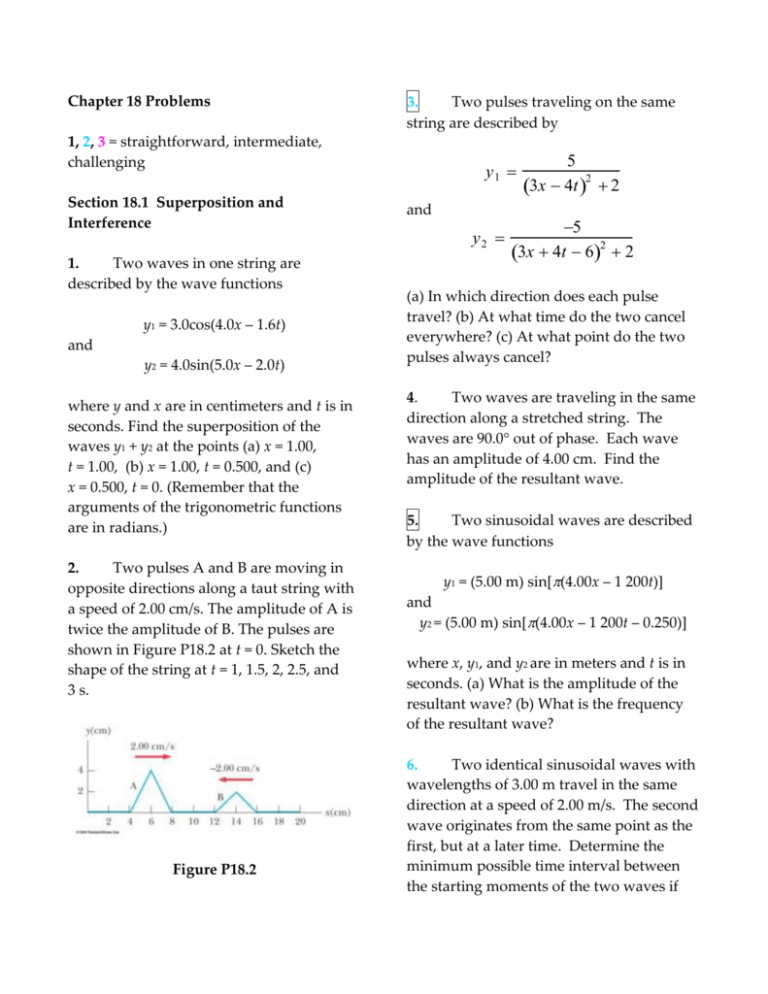
Chapter 18 Problems
3.
Two pulses traveling on the same
string are described by
1, 2, 3 = straightforward, intermediate,
challenging
Section 18.1 Superposition and
Interference
1.
Two waves in one string are
described by the wave functions
y1 = 3.0cos(4.0x – 1.6t)
and
y2 = 4.0sin(5.0x – 2.0t)
where y and x are in centimeters and t is in
seconds. Find the superposition of the
waves y1 + y2 at the points (a) x = 1.00,
t = 1.00, (b) x = 1.00, t = 0.500, and (c)
x = 0.500, t = 0. (Remember that the
arguments of the trigonometric functions
are in radians.)
2.
Two pulses A and B are moving in
opposite directions along a taut string with
a speed of 2.00 cm/s. The amplitude of A is
twice the amplitude of B. The pulses are
shown in Figure P18.2 at t = 0. Sketch the
shape of the string at t = 1, 1.5, 2, 2.5, and
3 s.
Figure P18.2
y1
and
y2
5
3x 4t 2 2
5
3x 4t 62 2
(a) In which direction does each pulse
travel? (b) At what time do the two cancel
everywhere? (c) At what point do the two
pulses always cancel?
4.
Two waves are traveling in the same
direction along a stretched string. The
waves are 90.0 out of phase. Each wave
has an amplitude of 4.00 cm. Find the
amplitude of the resultant wave.
5.
Two sinusoidal waves are described
by the wave functions
y1 = (5.00 m) sin[(4.00x – 1 200t)]
and
y2 = (5.00 m) sin[(4.00x – 1 200t – 0.250)]
where x, y1, and y2 are in meters and t is in
seconds. (a) What is the amplitude of the
resultant wave? (b) What is the frequency
of the resultant wave?
6.
Two identical sinusoidal waves with
wavelengths of 3.00 m travel in the same
direction at a speed of 2.00 m/s. The second
wave originates from the same point as the
first, but at a later time. Determine the
minimum possible time interval between
the starting moments of the two waves if
the amplitude of the resultant wave is the
same as that of each of the two initial
waves.
7.
Review problem. A series of pulses,
each of amplitude 0.150 m, is sent down a
string that is attached to a post at one end.
The pulses are reflected at the post and
travel back along the string without loss of
amplitude. What is the net displacement at
a point on the string where two pulses are
crossing, (a) if the string is rigidly attached
to the post? (b) if the end at which
reflection occurs is free to slide up and
down?
Figure P18.9 Problems 9 and 10.
8.
Two loudspeakers are placed on a
wall 2.00 m apart. A listener stands 3.00 m
from the wall directly in front of one of the
speakers. A single oscillator is driving the
speakers at a frequency of 300 Hz. (a) What
is the phase difference between the two
waves when they reach the observer? (b)
What If? What is the frequency closest to
300 Hz to which the oscillator may be
adjusted such that the observer hears
minimal sound?
10.
Two speakers are driven by the same
oscillator of frequency f. They are located a
distance d from each other on a vertical
pole. A man walks straight toward the
lower speaker in a direction perpendicular
to the pole, as shown in Figure P18.9. (a)
How many times will he hear a minimum
in sound intensity, and (b) how far is he
from the pole at these moments? Let v
represent the speed of sound and assume
that the ground does not reflect sound.
9.
Two speakers are driven by the same
oscillator of frequency 200 Hz. They are
located on a vertical pole a distance of
4.00 m from each other. A man walks
straight toward the lower speaker in a
direction perpendicular to the pole as
shown in Figure P18.9. (a) How many times
will he hear a minimum in sound intensity,
and (b) how far is he from the pole at these
moments? Take the speed of sound to be
330 m/s and ignore any sound reflections
coming off the ground.
11.
Two sinusoidal waves in a string are
defined by the functions
y1 = (2.00 cm) sin(20.0x – 32.0t)
and
y2 = (2.00 cm) sin(25.0x – 40.0t)
where y and x are in centimeters and t is in
seconds. (a) What is the phase difference
between these two waves at the point
x = 5.00 cm at t = 2.00 s? (b) What is the
positive x value closest to the origin for
which the two phases differ by at
t = 2.00 s? (This is where the two waves add
to zero.)
12.
Two identical speakers 10.0 m apart
are driven by the same oscillator with a
frequency of f = 21.5 Hz (Fig. P18.12). (a)
Explain why a receiver at point A records a
minimum in sound intensity from the two
speakers. (b) If the receiver is moved in the
plane of the speakers, what path should it
take so that the intensity remains at a
minimum? That is, determine the
relationship between x and y (the
coordinates of the receiver) that causes the
receiver to record a minimum in sound
intensity. Take the speed of sound to be
344 m/s.
y = (1.50 m) sin(0.400x) cos(200t)
where x is in meters and t is in seconds.
Determine the wavelength, frequency, and
speed of the interfering waves.
14.
by
Two waves in a long string are given
y 1 0.015 0 m cos
x
40t
2
and
y 2 0.015 0 m cos
x
40t
2
where y1, y2, and x are in meters and t is in
seconds. (a) Determine the positions of the
nodes of the resulting standing wave. (b)
What is the maximum transverse position
of an element of the string at the position
x = 0.400 m?
15.
Two speakers are driven in phase by
a common oscillator at 800 Hz and face
each other at a distance of 1.25 m. Locate
the points along a line joining the two
speakers where relative minima of sound
pressure amplitude would be expected.
(Use v = 343 m/s.)
Figure P18.12
Section 18.2 Standing Waves
13.
Two sinusoidal waves traveling in
opposite directions interfere to produce a
standing wave with the wave function
16.
Verify by direct substitution that the
wave function for a standing wave given in
Equation 18.3,
y = 2A sin kx cos t
is a solution of the general linear wave
equation, Equation 16.27:
2y 1 2y
x 2 v 2 t 2
17.
Two sinusoidal waves combining in
a medium are described by the wave
functions
y1 = (3.0 cm) sin(x + 0.60t)
and
y2 = (3.0 cm) sin(x – 0.60t)
where x is in centimeters and t is in
seconds. Determine the maximum
transverse position of an element of the
medium at (a) x = 0.250 cm, (b) x = 0.500 cm,
and (c) x = 1.50 cm. (d) Find the three
smallest values of x corresponding to
antinodes.
18.
Two waves that set up a standing
wave in a long string are given by the wave
functions
y1 = A sin(kx – t + )
and
y2 = A sin(kx + t)
Show (a) that the addition of the arbitrary
phase constant changes only the position
of the nodes, and in particular (b) that the
distance between nodes is still one half the
wavelength.
standing-wave patterns on a string that is
30.0 m long, has a mass per length of
9.00 10–3 kg/m, and is stretched to a
tension of 20.0 N.
20.
A string with a mass of 8.00 g and a
length of 5.00 m has one end attached to a
wall; the other end is draped over a pulley
and attached to a hanging object with a
mass of 4.00 kg. If the string is plucked,
what is the fundamental frequency of
vibration?
21.
In the arrangement shown in Figure
P18.21, an object can be hung from a string
(with linear mass density
=0.002 00 kg/m) that passes over a light
pulley. The string is connected to a vibrator
(of constant frequency f), and the length of
the string between point P and the pulley is
L = 2.00 m. When the mass m of the object
is either 16.0 kg or 25.0 kg, standing waves
are observed; however, no standing waves
are observed with any mass between these
values. (a) What is the frequency of the
vibrator? (Note: The greater the tension in
the string, the smaller the number of nodes
in the standing wave.) (b) What is the
largest object mass for which standing
waves could be observed?
Section 18.3 Standing Waves in a String
Fixed at Both Ends
19.
Find the fundamental frequency and
the next three frequencies that could cause
Figure P18.21 Problems 21 and 22.
22.
A vibrator, pulley, and hanging
object are arranged as in Figure P18.21,
with a compound string, consisting of two
strings of different masses and lengths
fastened together end-to-end. The first
string, which has a mass of 1.56 g and a
length of 65.8 cm, runs from the vibrator to
the junction of the two strings. The second
string runs from the junction over the
pulley to the suspended 6.93-kg object. The
mass and length of the string from the
junction to the pulley are, respectively,
6.75 g and 95.0 cm. (a) Find the lowest
frequency for which standing waves are
observed in both strings, with a node at the
junction. The standing wave patterns in the
two strings may have different numbers of
nodes. (b) What is the total number of
nodes observed along the compound string
at this frequency, excluding the nodes at the
vibrator and the pulley?
23.
Example 18.4 tells you that the
adjacent notes E, F, and F-sharp can be
assigned frequencies of 330 Hz, 350 Hz, and
370 Hz. You might not guess how the
pattern continues. The next notes, G, Gsharp, and A, have frequencies of 392 Hz,
416 Hz, and 440 Hz. On the equally
tempered or chromatic scale used in
Western music, the frequency of each
higher note is obtained by multiplying the
previous frequency by 12 2 . A standard
guitar has strings 64.0 cm long and nineteen
frets. In Example 18.4, we found the
spacings of the first two frets. Calculate the
distance between the last two frets.
24.
The top string of a guitar has a
fundamental frequency of 330 Hz when it is
allowed to vibrate as a whole, along all of
its 64.0-cm length from the neck to the
bridge. A fret is provided for limiting
vibration to just the lower two-thirds of the
string. If the string is pressed down at this
fret and plucked, what is the new
fundamental frequency? (b) What If? The
guitarist can play a “natural harmonic” by
gently touching the string at the location of
this fret and plucking the string at about
one-sixth of the way along its length from
the bridge. What frequency will be heard
then?
25.
A string of length L, mass per unit
length , and tension T is vibrating at its
fundamental frequency. What effect will
the following have on the fundamental
frequency? (a) The length of the string is
doubled, with all other factors held
constant. (b) The mass per unit length is
doubled, with all other factors held
constant. (c) The tension is doubled, with
all other factors held constant.
26.
A 60.000-cm guitar string under a
tension of 50.000 N has a mass per unit
length of 0.100 00 g/cm. What is the highest
resonant frequency that can be heard by a
person capable of hearing frequencies up to
20 000 Hz?
27.
A cello A-string vibrates in its first
normal mode with a frequency of 220 Hz.
The vibrating segment is 70.0 cm long and
has a mass of 1.20 g. (a) Find the tension in
the string. (b) Determine the frequency of
vibration when the string vibrates in three
segments.
28.
A violin string has a length of
0.350 m and is tuned to concert G, with
fG = 392 Hz. Where must the violinist place
her finger to play concert A, with
fA = 440 Hz? If this position is to remain
correct to one-half the width of a finger
(that is, to within 0.600 cm), what is the
maximum allowable percentage change in
the string tension?
29.
Review problem. A sphere of mass
M is supported by a string that passes over
a light horizontal rod of length L (Fig.
P18.29). Given that the angle is and that f
represents the fundamental frequency of
standing waves in the portion of the string
above the rod, determine the mass of this
portion of the string.
sound with a fundamental frequency of
300 Hz. If the copper cylinder is then
submerged in water so that half its volume
is below the water line, determine the new
fundamental frequency.
31.
A standing-wave pattern is observed
in a thin wire with a length of 3.00 m. The
equation of the wave is
y = (0.002 m) sin( x)cos(100 t)
where x is in meters and t is in seconds. (a)
How many loops does this pattern exhibit?
(b) What is the fundamental frequency of
vibration of the wire? (c) What If? If the
original frequency is held constant and the
tension in the wire is increased by a factor
of 9, how many loops are present in the
new pattern?
Section 18.4 Resonance
32.
The chains suspending a child's
swing are 2.00 m long. At what frequency
should a big brother push to make the child
swing with largest amplitude?
Figure P18.29
30.
Review problem. A copper cylinder
hangs at the bottom of a steel wire of
negligible mass. The top end of the wire is
fixed. When the wire is struck, it emits
33.
An earthquake can produce a seiche
in a lake, in which the water sloshes back
and forth from end to end with remarkably
large amplitude and long period. Consider
a seiche produced in a rectangular farm
pond, as in the cross-sectional view of
Figure P18.33. (The figure is not drawn to
scale.) Suppose that the pond is 9.15 m long
and of uniform width and depth. You
measure that a pulse produced at one end
reaches the other end in 2.50 s. (a) What is
the wave speed? (b) To produce the seiche,
several people stand on the bank at one end
and paddle together with snow shovels,
moving them in simple harmonic motion.
What should be the frequency of this
motion?
900 m/s, an opera singer would have to
produce a high harmonic with what
frequency to shatter the glass with a
resonant vibration?
Section 18.5 Standing Waves in Air
Columns
Note: Unless otherwise specified, assume
that the speed of sound in air is 343 m/s at
20C, and is described by
v 331 m / s 1
TC
273
at any Celsius temperature TC.
Figure P18.33
34.
The Bay of Fundy, Nova Scotia, has
the highest tides in the world. Assume that
in mid-ocean and at the mouth of the bay,
the Moon’s gravity gradient and the Earth’s
rotation make the water surface oscillate
with an amplitude of a few centimeters and
a period of 12 h 24 min. At the head of the
bay, the amplitude is several meters. Argue
for or against the proposition that the tide is
amplified by standing-wave resonance.
Assume the bay has a length of 210 km and
a uniform depth of 36.1 m. The speed of
long-wavelength water waves is given by
gd , where d is the water’s depth.
35.
Standing-wave vibrations are set up
in a crystal goblet with four nodes and four
antinodes equally spaced around the
20.0-cm circumference of its rim. If
transverse waves move around the glass at
36.
The overall length of a piccolo is
32.0 cm. The resonating air column vibrates
as in a pipe open at both ends. (a) Find the
frequency of the lowest note that a piccolo
can play, assuming that the speed of sound
in air is 340 m/s. (b) Opening holes in the
side effectively shortens the length of the
resonant column. If the highest note a
piccolo can sound is 4 000 Hz, find the
distance between adjacent antinodes for
this mode of vibration.
37.
Calculate the length of a pipe that
has a fundamental frequency of 240 Hz if
the pipe is (a) closed at one end and (b)
open at both ends.
38.
The fundamental frequency of an
open organ pipe corresponds to middle C
(261.6 Hz on the chromatic musical scale).
The third resonance of a closed organ pipe
has the same frequency. What are the
lengths of the two pipes?
39.
The windpipe of one typical
whooping crane is 5.00 feet long. What is
the fundamental resonant frequency of the
bird’s trachea, modeled as a narrow pipe
closed at one end? Assume a temperature
of 37° C.
40.
Do not stick anything into your ear!
Estimate the length of your ear canal, from
its opening at the external ear to the
eardrum. If you regard the canal as a
narrow tube that is open at one end and
closed at the other, at approximately what
fundamental frequency would you expect
your hearing to be most sensitive? Explain
why you can hear especially soft sounds
just around this frequency.
41.
A shower stall measures 86.0 cm
86.0 cm 210 cm. If you were singing in
this shower, which frequencies would
sound the richest (because of resonance)?
Assume that the stall acts as a pipe closed
at both ends, with nodes at opposite sides.
Assume that the voices of various singers
range from 130 Hz to 2 000 Hz. Let the
speed of sound in the hot shower stall be
355 m/s.
42.
As shown in Figure P18.42, water is
pumped into a tall vertical cylinder at a
volume flow rate R. The radius of the
cylinder is r, and at the open top of the
cylinder a tuning fork is vibrating with a
frequency f. As the water rises, how much
time elapses between successive
resonances?
Figure P18.42
43.
If two adjacent natural frequencies of
an organ pipe are determined to be 550 Hz
and 650 Hz, calculate the fundamental
frequency and length of this pipe.
(Use v = 340 m/s.)
44.
A glass tube (open at both ends) of
length L is positioned near an audio
speaker of frequency f = 680 Hz. For what
values of L will the tube resonate with the
speaker?
45.
An air column in a glass tube is open
at one end and closed at the other by a
movable piston. The air in the tube is
warmed above room temperature, and a
384-Hz tuning fork is held at the open end.
Resonance is heard when the piston is
22.8 cm from the open end and again when
it is 68.3 cm from the open end. (a) What
speed of sound is implied by these data? (b)
How far from the open end will the piston
be when the next resonance is heard?
46.
A tuning fork with a frequency of
512 Hz is placed near the top of the pipe
shown in Figure 18.19a. The water level is
lowered so that the length L slowly
increases from an initial value of 20.0 cm.
Determine the next two values of L that
correspond to resonant modes.
47.
When an open metal pipe is cut into
two pieces, the lowest resonance frequency
for the air column in one piece is 256 Hz
that for the other is 440 Hz. (a) What
resonant frequency would have been
produced by the original length of pipe? (b)
How long was the original pipe?
48.
With a particular fingering, a flute
plays a note with frequency 880 Hz at
20.0C. The flute is open at both ends. (a)
Find the air column length. (b) Find the
frequency it produces at the beginning of
the half-time performance at a late-season
American football game, when the ambient
temperature is –5.00C and the player has
not had a chance to warm up the flute.
Section 18.6 Standing Waves in Rods and
Membranes
49.
An aluminum rod 1.60 m long is
held at its center. It is stroked with a rosincoated cloth to set up a longitudinal
vibration. The speed of sound in a thin rod
of aluminum is 5 100 m/s. (a) What is the
fundamental frequency of the waves
established in the rod? (b) What harmonics
are set up in the rod held in this manner?
(c) What If? What would be the
fundamental frequency if the rod were
copper, in which the speed of sound is
3 560 m/s?
50.
An aluminum rod is clamped one
quarter of the way along its length and set
into longitudinal vibration by a variablefrequency driving source. The lowest
frequency that produces resonance is
4 400 Hz. The speed of sound in an
aluminum rod is 5 100 m/s. Determine the
length of the rod.
Section 18.7 Beats: Interference in Time
51.
In certain ranges of a piano
keyboard, more than one string is tuned to
the same note to provide extra loudness.
For example, the note at 110 Hz has two
strings at this frequency. If one string slips
from its normal tension of 600 N to 540 N,
what beat frequency is heard when the
hammer strikes the two strings
simultaneously?
52.
While attempting to tune the note C
at 523 Hz, a piano tuner hears 2 beats/s
between a reference oscillator and the
string. (a) What are the possible frequencies
of the string? (b) When she tightens the
string slightly, she hears 3 beats/s. What is
the frequency of the string now? (c) By
what percentage should the piano tuner
now change the tension in the string to
bring it into tune?
53.
A student holds a tuning fork
oscillating at 256 Hz. He walks toward a
wall at a constant speed of 1.33 m/s. (a)
What beat frequency does he observe
between the tuning fork and its echo? (b)
How fast must he walk away from the wall
to observe a beat frequency of 5.00 Hz?
54.
When beats occur at a rate higher
than about 20 per second, they are not
heard individually but rather as a steady
hum, called a combination tone. The player
of a typical pipe organ can press a single
key and make the organ produce sound
with different fundamental frequencies.
She can select and pull out different stops
to make the same key for the note C
produce sound at the following frequencies:
65.4 Hz from a so-called eight-foot pipe;
2 65.4 = 131 Hz from a four-foot pipe;
3 65.4 = 196 Hz from a two-and-twothirds-foot pipe; 4 65.4 = 262 Hz from a
two-foot pipe; or any combination of these.
With notes at low frequencies, she obtains
sound with the richest quality by pulling
out all the stops. When an air leak develops
in one of the pipes, that pipe cannot be
used. If a leak occurs in an eight-foot pipe,
playing a combination of other pipes can
create the sensation of sound at the
frequency that the eight-foot pipe would
produce. Which sets of stops, among those
listed, could be pulled out to do this?
Section 18.8 Non-Sinusoidal Wave
Patterns
55.
An A-major chord consists of the
notes called A, C#, and E. It can be played
on a piano by simultaneously striking
strings with fundamental frequencies of
440.00 Hz, 554.37 Hz, and 659.26 Hz. The
rich consonance of the chord is associated
with near equality of the frequencies of
some of the higher harmonics of the three
tones. Consider the first five harmonics of
each string and determine which harmonics
show near equality.
56.
Suppose that a flutist plays a 523-Hz
C note with first harmonic displacement
amplitude A1 = 100 nm. From Figure 18.24b
read, by proportion, the displacement
amplitudes of harmonics 2 through 7. Take
these as the values A2 through A7 in the
Fourier analysis of the sound, and assume
that B1 = B2 = … = B7 = 0. Construct a graph
of the waveform of the sound. Your
waveform will not look exactly like the
flute waveform in Figure 18.23b because
you simplify by ignoring cosine terms;
nevertheless, it produces the same
sensation to human hearing.
Additional Problems
57.
On a marimba, the wooden bar that
sounds a tone when struck vibrates in a
transverse standing wave having three
antinodes and two nodes. The lowest
frequency note is 87.0 Hz, produced by a
bar 40.0 cm long. (a) Find the speed of
transverse waves on the bar. (b) A resonant
pipe suspended vertically below the center
of the bar enhances the loudness of the
emitted sound. If the pipe is open at the
top end only and the speed of sound in air
is 340 m/s, what is the length of the pipe
required to resonate with the bar in part
(a)?
58.
A speaker at the front of a room and
an identical speaker at the rear of the room
are being driven by the same oscillator at
456 Hz. A student walks at a uniform rate
of 1.50 m/s along the length of the room.
She hears a single tone, repeatedly
becoming louder and softer. (a) Model
these variations as beats between the
Doppler-shifted sounds the student
receives. Calculate the number of beats the
student hears each second. (b) What If?
Model the two speakers as producing a
standing wave in the room and the student
as walking between antinodes. Calculate
the number of intensity maxima the student
hears each second.
59.
Two train whistles have identical
frequencies of 180 Hz. When one train is at
rest in the station and the other is moving
nearby, a commuter standing on the station
platform hears beats with a frequency of
2.00 beats/s when the whistles sound at the
same time. What are the two possible
speeds and directions that the moving train
can have?
60.
A string fixed at both ends and
having a mass of 4.80 g, a length of 2.00 m,
and a tension of 48.0 N vibrates in its
second (n = 2) normal mode. What is the
wavelength in air of the sound emitted by
this vibrating string?
61.
A student uses an audio oscillator of
adjustable frequency to measure the depth
of a water well. The student hears two
successive resonances at 51.5 Hz and 60.0
Hz. How deep is the well?
62.
A string has a mass per unit length
of 9.00 10–3 kg/m. What must be the
tension in the string if its second harmonic
has the same frequency as the second
resonance mode of a 1.75-m-long pipe open
at one end?
63.
Two wires are welded together end
to end. The wires are made of the same
material, but the diameter of one is twice
that of the other. They are subjected to a
tension of 4.60 N. The thin wire has a length
of 40.0 cm and a linear mass density of
2.00 g/m. The combination is fixed at both
ends and vibrated in such a way that two
antinodes are present, with the node
between them being right at the weld. (a)
What is the frequency of vibration? (b) How
long is the thick wire?
64.
Review problem. For the
arrangement shown in Figure P18.64,
= 30.0, the inclined plane and the small
pulley are frictionless, the string supports
the object of mass M at the bottom of the
plane, and the string has mass m that is
small compared to M. The system is in
equilibrium and the vertical part of the
string has a length h. Standing waves are
set up in the vertical section of the string.
(a) Find the tension in the string. (b) Model
the shape of the string as one leg and the
hypotenuse of a right triangle. Find the
whole length of the string. (c) Find the mass
per unit length of the string. (d) Find the
speed of waves on the string. (e) Find the
lowest frequency for a standing wave. (f)
Find the period of the standing wave
having three nodes. (g) Find the
wavelength of the standing wave having
three nodes. (h) Find the frequency of the
beats resulting from the interference of the
sound wave of lowest frequency generated
by the string with another sound wave
having a frequency that is 2.00% greater.
the wire, a beat frequency of 5.00 Hz is
heard. (a) What could be the frequency of
the tuning fork? (b) What should the
tension in the wire be if the beats are to
disappear?
67.
Two waves are described by the
wave functions
y1(x, t) = 5.0 sin(2.0x – 10t)
and
y2(x, t) = 10 cos(2.0x – 10t)
Figure P18.64
65.
A standing wave is set up in a string
of variable length and tension by a vibrator
of variable frequency. Both ends of the
string are fixed. When the vibrator has a
frequency f, in a string of length L and
under tension T, n antinodes are set up in
the string. (a) If the length of the string is
doubled, by what factor should the
frequency be changed so that the same
number of antinodes is produced? (b) If the
frequency and length are held constant,
what tension will produce n + 1 antinodes?
(c) If the frequency is tripled and the length
of the string is halved, by what factor
should the tension be changed so that twice
as many antinodes are produced?
66.
A 0.010 0-kg wire, 2.00 m long, is
fixed at both ends and vibrates in its
simplest mode under a tension of 200 N.
When a vibrating tuning fork is placed near
where y1, y2, and x are in meters and t is in
seconds. Show that the wave resulting
from their superposition is also sinusoidal.
Determine the amplitude and phase of this
sinusoidal wave.
68.
The wave function for a standing
wave is given in Equation 18.3 as
y = 2A sin kx cos t. (a) Rewrite this wave
function in terms of the wavelength and
the wave speed v of the wave. (b) Write the
wave function of the simplest standingwave vibration of a stretched string of
length L. (c) Write the wave function for
the second harmonic. (d) Generalize these
results and write the wave function for the
nth resonance vibration.
69.
Review problem. A 12.0-kg object
hangs in equilibrium from a string with a
total length of L = 5.00 m and a linear mass
density of = 0.001 00 kg/m. The string is
wrapped around two light, frictionless
pulleys that are separated by a distance of
d = 2.00 m (Fig. P18.69a). (a) Determine the
tension in the string. (b) At what frequency
must the string between the pulleys vibrate
in order to form the standing wave pattern
shown in Figure P18.69b?
Figure P18.69
© Copyright 2004 Thomson. All rights reserved.
70.
A quartz watch contains a crystal
oscillator in the form of a block of quartz
that vibrates by contracting and expanding.
Two opposite faces of the block, 7.05 mm
apart, are antinodes, moving alternately
toward each other and away from each
other. The plane halfway between these
two faces is a node of the vibration. The
speed of sound in quartz is 3.70 km/s. Find
the frequency of the vibration. An
oscillating electric voltage accompanies the
mechanical oscillation—the quartz is
described as piezoelectric. An electric circuit
feeds in energy to maintain the oscillation
and also counts the voltage pulses to keep
time.


